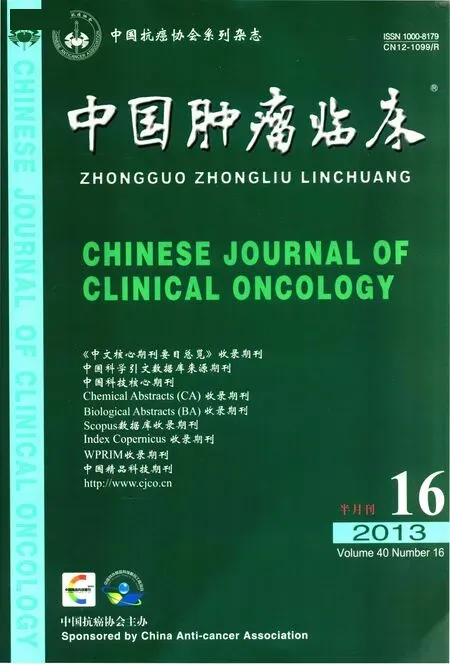唑来膦酸在早期乳腺癌中的抗肿瘤研究进展
张丽娜 杨艳芳 综述 顾 林 审校
唑来膦酸在早期乳腺癌中的抗肿瘤研究进展
张丽娜 杨艳芳 综述 顾 林 审校
早期乳腺癌在接受辅助治疗(化疗和内分泌治疗)时均会对患者骨密度造成不良影响,加速骨丢失。第三代双磷酸盐—唑来膦酸其作用机制是抑制破骨细胞介导的骨质重吸收,主要用于恶性肿瘤骨转移引起的高钙血症。唑来膦酸-弗隆辅助协同试验(ZO-FAST)显示唑来膦酸在早期乳腺癌辅助内分泌治疗同时使用不仅可有效防止骨质丢失,还具有明显降低肿瘤复发的作用。奥地利乳腺癌和结直肠癌研究小组-12(ABCSG-12)试验结果同样表明唑来膦酸在联合内分泌治疗时可显著降低患者的疾病进展风险和死亡风险。除此之外,临床前实验和临床试验也证实唑来膦酸联合化疗也具有协同的抗肿瘤作用。唑来膦酸联合新辅助化疗降低复发(AZURE试验),对于绝经5年以上和年龄>60岁的人群,辅助化疗加唑来膦酸显著减低疾病进展和死亡风险。在ABCSG-12试验中同样发现对于年龄>40岁的患者,唑来膦酸可明显降低复发风险,而年龄≤40岁患者却未在唑来膦酸的治疗中获益。这些结果表明唑来膦酸在雌激素低水平(自然的或治疗后结果)的早期乳腺癌患者中易于发挥抗肿瘤作用。目前对于唑来膦酸的最佳剂量和持续时间尚有待于进一步的研究确认,相信随着相关临床试验结果的公布可以提供更充足的证据来支持唑来膦酸在早期乳腺癌的使用。
早期乳腺癌 唑来膦酸 骨转移 抗肿瘤
乳腺癌是女性最常见的恶性肿瘤,每年约140万新发病例[1]。随着早期诊断和综合治疗技术的发展完善,乳腺癌患者的预后有了明显提高,早期(Ⅰ、Ⅱ期)5年总生存率(overall survival,OS)约98%,局部晚期Ⅲ期5年OS约84%,Ⅳ期5年OS约27%[1]。虽然根据其临床及生物学特征,大部分乳腺癌患者接受系统的综合治疗,但仍有部分患者会出现局部复发和远处转移;并且乳腺癌的远处转移有一定的器官转移倾向,5年内复发的乳腺癌患者中有超过35%的比例出现骨转移[2],而对于转移性乳腺癌患者约有80%合并骨转移[3]。双磷酸盐是近年研发的抗代谢性骨病的一类药物,主要抑制破骨细胞介导的骨质破坏,目前主要用于治疗骨质疏松和恶性肿瘤引起的高钙血症。唑来膦酸是第三代双磷酸盐药物,临床前试验证实其为迄今已发现抗骨吸收能力最强的药物,抑制破骨细胞活性比第二代双磷酸盐-帕米膦酸二钠强50~100倍,已被应用于伴骨转移的晚期癌症患者中。而目前多项研究发现,唑来膦酸应用于早期乳腺癌患者中,对其辅助化疗和内分泌治疗所致的骨密度不良事件有明显的预防和改善作用,同时还具有明显的抗肿瘤作用[4-5],本文将就此展开综述。
1 唑来膦酸抗肿瘤的临床前研究
众多临床前实验表明,唑来膦酸对于多种肿瘤细胞系有直接的抗肿瘤作用[6],可阻止肿瘤细胞的粘附和浸润,同时诱导凋亡[7]。Wood等[8]发现唑来膦酸可抑制由血管内皮生长因子(vascular endothelial growth factor,VEGF)刺激引起的内皮细胞增殖,而在体外培养的鼠主动脉环中加入唑来膦酸可以显著降低血管生成,由此表明唑来膦酸具有抑制新生血管的作用。除了单独的抑瘤作用外,唑来膦酸还与化疗具有协同作用。Neville-Webbe等[9]研究发现,在体外实验中唑来膦酸与紫杉醇具有协同诱导乳腺癌细胞凋亡的作用。在MCF-7乳腺癌细胞中发现,无论是同时加入唑来膦酸和紫杉醇,还是先后使用唑来膦酸和紫杉醇均比单药引起的细胞凋亡要多,结果有统计学意义。但是先用紫杉醇后用唑来膦酸显示出更强的诱导细胞凋亡作用,表明细胞毒药物刺激肿瘤细胞后可使肿瘤细胞更敏感于唑来膦酸的诱导凋亡作用。这种与化疗药物的协同作用在动物实验中也得到证实。Ottewell等[10]将乳腺癌细胞MDA-MB-436种植于裸鼠皮下,7天后每周分别注射盐水、多柔比星、唑来膦酸、多柔比星同时唑来膦酸、唑来膦酸后多柔比星、多柔比星后唑来膦酸,各组均给药6周。结果发现单用唑来膦酸和唑来膦酸后多柔比星组均未显示出明显的抑瘤作用,而同时给药和先化疗后唑来膦酸组能够显著抑制肿瘤的生长,尤其是后者的抗肿瘤效果突出。进一步说明化疗后使用唑来膦酸能发挥出更强的抑制肿瘤效应。
2 唑来膦酸抗肿瘤的临床研究
唑来膦酸-弗隆辅助协同试验(Zometa-Femara Adjuvant Synergy Trial,ZO-FAST)主要是研究唑来膦酸对于内分泌治疗带来的骨丢失和骨折风险的防护作用,试验最初设计的首要研究终点是观察在第12个月时腰椎骨密度改变情况[11]。1 065例患者随机分为来曲唑、唑来膦酸同时治疗组(来曲唑同时使用唑来膦酸,每半年1次,共治疗5年)和延迟治疗组(出现骨质疏松或骨折等不良事件时使用唑来膦酸)。随访12个月时结果显示同时给药组患者的骨折发生率明显低于延迟给药组,提示在接受来曲唑辅助治疗的同时立即给予唑来膦酸可以有效地防止骨丢失[11]。但随访到36个月时发现同时给药组较延迟给药组除了能预防骨相关事件外,在减少肿瘤复发方面同样发挥作用,无论是在局部复发(2例vs.10例)还是在远处复发(20例vs.30例)方面两组差异均有统计学意义,骨转移更是比较明显(9例vs.17例)。统计学结果证实来曲唑同时使用唑来膦酸较延迟使用治疗组可将无瘤生存时间(disease free survival,DFS)相对危险度降低 41%(OR:0.588,95%CI:0.361~0.959%,P=0.033 14)[12]。这一结果可以看出唑来膦酸和内分泌治疗药物具有协同作用,内分泌治疗同时使用唑来膦酸不仅有效防止骨丢失,而且还能降低肿瘤复发风险。
唑来膦酸联合新辅助化疗降低复发(Neo-Adjuvant Zoledronic Acid to Reduce Recurrence,AZURE)临床试验的目的是了解唑来膦酸联合化疗是否可以产生协同作用[13]。该试验将3 360例Ⅱ、Ⅲ期乳腺癌患者随机分为新辅助化疗组和新辅助化疗加用唑来膦酸组,唑来膦酸给药方法为前半年每月1次,之后2年内每3个月1次,最后2年半每6个月1次,共5年[13]。在对于205例接受新辅助治疗患者进行探索性分析时发现化疗联用唑来膦酸可以降低残存浸润癌直径约43.4%(15.5 mm vs.27.4 mm,P=0.006),提高病理缓解率约2倍(11.7%vs.6.9%,P=0.146),表明唑来膦酸联合细胞毒药物有协同作用[13]。尽管前期结果显示唑来膦酸抗肿瘤活性显著,但后续随访发现化疗联合唑来膦酸在总体上并未改善DFS,仅观察到总生存有改善趋势,原因尚不明确。但在基于月经状态的分析中发现,对于入组时绝经5年以上的人群,辅助化疗加唑来膦酸可将DFS风险降低24%,在绝经5年以上和超过60岁的人群中,死亡风险可降低29%[14]。此结果表明唑来膦酸发挥作用与雌激素水平有密切关系,低雌激素水平的患者更易于在唑来膦酸治疗时获益。
奥地利乳腺癌和结直肠癌研究小组-12(Austrian Breast and Colorectal Cancer Study Group-12,ABCSG-12)是一项观察唑来膦酸和内分泌治疗联合应用的随机Ⅲ期临床试验,不同之处在于该试验将DFS作为首要研究终点,总生存和骨密度作为次要研究终点[2]。1 803例早期绝经前激素反应性乳腺癌患者被随机分为4组,对照组使用戈舍瑞林(3.6 mg/28 d)联合他莫昔芬(20 mg/d)或阿那曲唑(1 mg/d),试验组在对照组的基础上加用唑来膦酸(4 mg/6个月,时间为3年)。中位随访47.8个月时发现全部患者中共137例复发,单独接受内分泌治疗组83例,其中骨转移23例;联合唑来膦酸组54例复发,其中骨转移16例。在DFS方面,仅内分泌治疗组为90.8%,联合唑来膦酸治疗组为94%,与单用内分泌治疗相比,唑来膦酸将患者DFS提高了3.2%,同时将疾病进展风险降低36%(OR:0.64,95%CI:0.46~0.91%,P=0.01);在死亡风险方面,加用唑来膦酸治疗并无优势[2]。在中位随访62个月时共有186例复发,其中单独接受内分泌治疗组110例,骨转移32例;联合唑来膦酸组76例,骨转移21例。在DFS方面,仅内分泌治疗组为88%,联合唑来膦酸治疗组为92%,与单用内分泌治疗相比,唑来膦酸组患者DFS提高了4%,疾病进展风险降低32%(OR:0.68,95%CI:0.51~0.91%,P=0.009);死亡风险方面,两组间仍无显著性差异[15]。这说明对于接受内分泌治疗的早期乳腺癌患者同时使用唑来膦酸即使在治疗结束2年以后仍能获得生存获益。ABSCG-12亚组分析发现淋巴结是否转移对于唑来膦酸的疗效无影响,即使对于淋巴结转移的患者也能降低复发风险。然而在年龄亚组分析中却发现了差异,对于年龄≤40岁患者,唑来膦酸并未降低疾病复发的相对危险(OR:0.94,95%CI:0.57~1.56);而年龄>40岁的患者其复发风险却明显降低(OR:0.58,95%CI:0.40~0.83)。此结果与AZURE的结果有一致性,表明唑来膦酸对于低雌激素水平患者能带来更大的生存获益。
3 总结
临床前和临床研究提供了充足的数据来支持唑来膦酸的抗肿瘤作用。AZURE和ABCSG-12这两项临床试验的数据表明唑来膦酸对于雌激素低水平(自然的或治疗后的结果)的早期乳腺癌患者抗肿瘤作用明显。ABCSG-12数据表明通过戈舍瑞林抑制导致闭经状态的绝经前患者使用唑来膦酸可以获得显著和持久的DFS。此外,在ABCSG-12试验中,DFS获益人群大多数是年龄>40岁,此类患者比年龄≤40岁的女性更有可能已经完全卵巢抑制,而这些患者的残留雌激素水平和AZURE试验中绝经后的人群相似。随着这些试验结果成熟,可以提供更充足的证据证明唑来膦酸在早期乳腺癌中的抗肿瘤机制。正在进行的其他临床试验(NSABP B-34,SWOG 0307,GAIN)也会在将来提供额外的信息来证实唑来膦酸在早期乳腺癌中明确的抗肿瘤作用。
1 Siegel R,Naishadham D,Jemal A.Cancer statistics,2013[J].CA Cancer J Clin,2013,63(1):11-30.
2 Gnant M,Mlineritsch B,Schippinger W,et al.Endocrine therapy plus zoledronic acid in premenopausal breast cancer[J].N Engl J Med,2009,360(7):679-691.
3 Coleman RE.Adjuvant bisphosphonates in breast cancer:are we witnessing the emergence of a new therapeutic strategy[J]?Eur J Cancer,2009,45(11):1909-1915.
4 Coscia M,Quaglino E,Iezzi M,et al.Zoledronic acid repolarizes tumour-associated macrophages and inhibits mammary carcinogenesis by targetingthe mevalonate pathway[J].J Cell Mol Med,2010,14(12):2803-2815.
5 Shapiro CL,Halabi S,Hars V,et al.Zoledronic acid preserves bone mineral density in premenopausal women who develop ovarian failure due toadjuvant chemotherapy:final results from CALGB trial 79809[J].Eur J Cancer,2011,47(5):683-689.
6 Räikkönen J,Mönkkönen H,Auriola S,et al.Mevalonate pathway intermediates downregulate zoledronic acid-induced isopentenyl pyrophosphate and ATP analog formation in human breast cancer cells[J].Biochem Pharmacol,2010,79(5):777-783.
7 Yamada J,Tsuno NH,Kitayama J,et al.Anti-angiogenic property of zoledronic acid by inhibition of endothelial progenitor cell differentiation[J].J Surg Res,2009,151(1):115-120.
8 Wood J,Bonjean K,Ruetz S,et al.Novel antiangiogenic effects of the bisphosphonate compound zoledronic acid[J].J Pharmacol Exp Ther,2002,302(3):1055-1061.
9 Neville-Webbe HL,Evans CA,Coleman RE,et al.Mechanisms of the synergistic interaction between the bisphosphonate zoledronic acid and the chemotherapyagent paclitaxel in breast cancer cells in vitro[J].Tumour Biol,2006,27(2):92-103.
10 Ottewell PD,Mönkkönen H,Jones M,et al.Antitumor effects of doxorubicin followed by zoledronic acid in a mouse model of breast cancer[J].J Natl Cancer Inst,2008,100(16):1167-1178.
11 Bundred NJ,Campbell ID,Davidson N,et al.Effective inhibition of aromatase inhibitor-associated bone loss by zoledronic acid in postmenopausal womenwith early breast cancer receiving adjuvant letrozole:ZO-FAST Study results[J].Cancer,2008,112(5):1001-1010.
12 Eidtmann H,de Boer R,Bundred N,et al.Efficacy of zoledronic acid in postmenopausal women with early breast cancer receiving adjuvant letrozole:36-month results of the ZO-FAST Study[J].Ann Oncol,2010,21(11):2188-2194.
13 Coleman RE,Winter MC,Cameron D,et al.The effects of adding zoledronic acid to neoadjuvant chemotherapy on tumour response:exploratory evidencefor direct anti-tumour activity in breast cancer[J].Br J Cancer,2010,102(7):1099-1105.
14 Coleman RE,Marshall H,Cameron D,et al.Breast-cancer adjuvant therapy with zoledronic acid[J].N Engl J Med,2011,365(15):1396-1405.
15 Gnant M,Mlineritsch B,Stoeger H,et al.Adjuvant endocrine therapy plus zoledronic acid in premenopausal women with early-stage breast cancer:62-month follow-up from the ABCSG-12 randomised trial[J].Lancet Oncol,2011,12(7):631-641.
(2013-04-30收稿)
(2013-06-28修回)
Research progress in antitumor effects of zoledronic acid in early breast cancer
Lin GU;E-mail:gulindr@yahoo.com
The Second Department of Breast Cancer,Tianjin Medical University Cancer Institute and Hospital;Key Laboratory of Breast Cancer Prevention and Therapy,Ministry of Education;Tianjin Key Laboratory of Cancer Prevention and Therapy,Tianjin 300060,China
Adjuvant treatment,which includes chemotherapy and endocrine therapy,for early breast cancer may impair bone density,resulting in bone loss.The third generation bisphosphonate-zoledronic is an anti-resorptive agent that inhibits osteoclast-mediated bone resorption.This drug can be mainly used in the treatment of hypercalcemia caused by bone metastases of the cancer.The Zometa-Femara Adjuvant Synergy Trial revealed that immediate zoledronic acid and endocrine therapy not only prevents bone loss,but also reduces recurrence.The Austrian Breast and Colorectal Cancer Study Group-12(ABCSG-12)also confirmed that zoledronic acid,when combined with endocrine therapy,could reduce the risk of cancer disease progression and death.Moreover,preclinical studies and clinical trials have demonstrated the synergistic antitumor effects of chemotherapy and zoledronic acid.Neo-adjuvant zoledronic acid to reduce recurrence trials showed that the addition of zoledronic acid to adjuvant chemotherapy significantly reduced the risk of disease progression and death in postmenopausal women more than five years postmenopause at the beginning of the study or over 60 years of age at the baseline.The ABCSG-12 subgroup analysis based on age(≤40 years or>40 years)also showed that zoledronic acid can significantly improve the prognosis in women who were over 40 years at the study entry.These results suggest that zoledronic acid administration in patients with lowered estrogen levels(naturally or as a consequence of adjuvant treatment)easily exerts anti-tumor effects.However,the optimal dose and duration of zoledronic acid requires further studies.More clinical trials should be performed to provide sufficient evidence to support the effectiveness of zoledronic acid in the treatment of early breast cancer.
early breast cancer,zoledronic acid,bone metastasis,antitumor
10.3969/j.issn.1000-8179.20130676
天津医科大学肿瘤医院乳腺二科,国家肿瘤临床医学研究中心,乳腺癌防治教育部重点实验室(天津市300060)
顾林 gulindr@yahoo.com
Lina ZHANG,Yanfang YANG,Lin GU
(本文编辑:邢颖)

